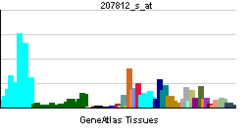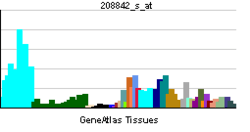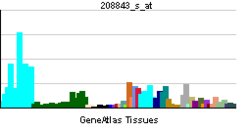GORASP2
| GORASP2 | |||||||||||||||||
|---|---|---|---|---|---|---|---|---|---|---|---|---|---|---|---|---|---|
| |||||||||||||||||
| Identifiers | |||||||||||||||||
| Aliases | GORASP2, GOLPH6, GRASP55, GRS2, p59, golgi reassembly stacking protein 2 | ||||||||||||||||
| External IDs | MGI: 2135962 HomoloGene: 9180 GeneCards: GORASP2 | ||||||||||||||||
| |||||||||||||||||
| RNA expression pattern | |||||||||||||||||
   | |||||||||||||||||
| More reference expression data | |||||||||||||||||
| Orthologs | |||||||||||||||||
| Species | Human | Mouse | |||||||||||||||
| Entrez | |||||||||||||||||
| Ensembl | |||||||||||||||||
| UniProt | |||||||||||||||||
| RefSeq (mRNA) | |||||||||||||||||
| RefSeq (protein) | |||||||||||||||||
| Location (UCSC) | Chr 2: 170.93 – 170.97 Mb | Chr 2: 70.66 – 70.71 Mb | |||||||||||||||
| PubMed search | [1] | [2] | |||||||||||||||
| Wikidata | |||||||||||||||||
| View/Edit Human | View/Edit Mouse |
Golgi reassembly-stacking protein 2 is a protein that in humans is encoded by the GORASP2 gene.[3][4]
The Golgi complex plays a key role in the sorting and modification of proteins exported from the endoplasmic reticulum. The protein encoded by this gene is involved in establishing the stacked structure of the Golgi apparatus.[4]
Interactions
GORASP2 has been shown to interact with BLZF1,[5] TGF alpha,[5] TMED2[5] and GOLGA2.[3][5][6]
References
- ↑ "Human PubMed Reference:".
- ↑ "Mouse PubMed Reference:".
- 1 2 Shorter J, Watson R, Giannakou ME, Clarke M, Warren G, Barr FA (Nov 1999). "GRASP55, a second mammalian GRASP protein involved in the stacking of Golgi cisternae in a cell-free system". EMBO J. 18 (18): 4949–60. doi:10.1093/emboj/18.18.4949. PMC 1171566
 . PMID 10487747.
. PMID 10487747. - 1 2 "Entrez Gene: GORASP2 golgi reassembly stacking protein 2, 55kDa".
- 1 2 3 4 Barr, F A; Preisinger C; Kopajtich R; Körner R (Dec 2001). "Golgi matrix proteins interact with p24 cargo receptors and aid their efficient retention in the Golgi apparatus". J. Cell Biol. United States. 155 (6): 885–91. doi:10.1083/jcb.200108102. ISSN 0021-9525. PMC 2150891
 . PMID 11739402.
. PMID 11739402. - ↑ Short, B; Preisinger C; Körner R; Kopajtich R; Byron O; Barr F A (Dec 2001). "A GRASP55-rab2 effector complex linking Golgi structure to membrane traffic". J. Cell Biol. United States. 155 (6): 877–83. doi:10.1083/jcb.200108079. ISSN 0021-9525. PMC 2150909
 . PMID 11739401.
. PMID 11739401.
Further reading
- Maruyama K, Sugano S (1994). "Oligo-capping: a simple method to replace the cap structure of eukaryotic mRNAs with oligoribonucleotides.". Gene. 138 (1-2): 171–4. doi:10.1016/0378-1119(94)90802-8. PMID 8125298.
- Suzuki Y, Yoshitomo-Nakagawa K, Maruyama K, et al. (1997). "Construction and characterization of a full length-enriched and a 5'-end-enriched cDNA library.". Gene. 200 (1-2): 149–56. doi:10.1016/S0378-1119(97)00411-3. PMID 9373149.
- Kuo A, Zhong C, Lane WS, Derynck R (2001). "Transmembrane transforming growth factor-alpha tethers to the PDZ domain-containing, Golgi membrane-associated protein p59/GRASP55.". EMBO J. 19 (23): 6427–39. doi:10.1093/emboj/19.23.6427. PMC 305863
 . PMID 11101516.
. PMID 11101516. - Jesch SA, Lewis TS, Ahn NG, Linstedt AD (2001). "Mitotic phosphorylation of Golgi reassembly stacking protein 55 by mitogen-activated protein kinase ERK2.". Mol. Biol. Cell. 12 (6): 1811–7. doi:10.1091/mbc.12.6.1811. PMC 37343
 . PMID 11408587.
. PMID 11408587. - Short B, Preisinger C, Körner R, et al. (2002). "A GRASP55-rab2 effector complex linking Golgi structure to membrane traffic.". J. Cell Biol. 155 (6): 877–83. doi:10.1083/jcb.200108079. PMC 2150909
 . PMID 11739401.
. PMID 11739401. - Barr FA, Preisinger C, Kopajtich R, Körner R (2002). "Golgi matrix proteins interact with p24 cargo receptors and aid their efficient retention in the Golgi apparatus.". J. Cell Biol. 155 (6): 885–91. doi:10.1083/jcb.200108102. PMC 2150891
 . PMID 11739402.
. PMID 11739402. - Lane JD, Lucocq J, Pryde J, et al. (2002). "Caspase-mediated cleavage of the stacking protein GRASP65 is required for Golgi fragmentation during apoptosis.". J. Cell Biol. 156 (3): 495–509. doi:10.1083/jcb.200110007. PMC 2173349
 . PMID 11815631.
. PMID 11815631. - Strausberg RL, Feingold EA, Grouse LH, et al. (2003). "Generation and initial analysis of more than 15,000 full-length human and mouse cDNA sequences.". Proc. Natl. Acad. Sci. U.S.A. 99 (26): 16899–903. doi:10.1073/pnas.242603899. PMC 139241
 . PMID 12477932.
. PMID 12477932. - Ota T, Suzuki Y, Nishikawa T, et al. (2004). "Complete sequencing and characterization of 21,243 full-length human cDNAs.". Nat. Genet. 36 (1): 40–5. doi:10.1038/ng1285. PMID 14702039.
- Gerhard DS, Wagner L, Feingold EA, et al. (2004). "The status, quality, and expansion of the NIH full-length cDNA project: the Mammalian Gene Collection (MGC).". Genome Res. 14 (10B): 2121–7. doi:10.1101/gr.2596504. PMC 528928
 . PMID 15489334.
. PMID 15489334. - Rual JF, Venkatesan K, Hao T, et al. (2005). "Towards a proteome-scale map of the human protein-protein interaction network.". Nature. 437 (7062): 1173–8. doi:10.1038/nature04209. PMID 16189514.
- Gandhi TK, Zhong J, Mathivanan S, et al. (2006). "Analysis of the human protein interactome and comparison with yeast, worm and fly interaction datasets.". Nat. Genet. 38 (3): 285–93. doi:10.1038/ng1747. PMID 16501559.
- Beausoleil SA, Villén J, Gerber SA, et al. (2006). "A probability-based approach for high-throughput protein phosphorylation analysis and site localization.". Nat. Biotechnol. 24 (10): 1285–92. doi:10.1038/nbt1240. PMID 16964243.
- Olsen JV, Blagoev B, Gnad F, et al. (2006). "Global, in vivo, and site-specific phosphorylation dynamics in signaling networks.". Cell. 127 (3): 635–48. doi:10.1016/j.cell.2006.09.026. PMID 17081983.
This article is issued from Wikipedia - version of the 5/31/2016. The text is available under the Creative Commons Attribution/Share Alike but additional terms may apply for the media files.